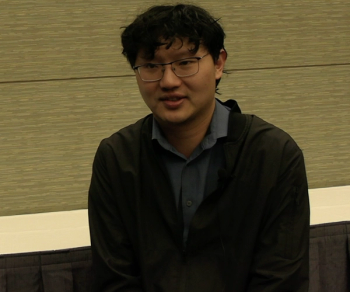
LCGC Interviews
Latest News
Latest Videos

More News

Here is some of the most popular content posted on LCGC International this week.

Silvia Radenkovic is a laboratory clinical biochemical genetics fellow at UMC Utrecht, the Netherlands and a member of Females in Mass Spectrometry (FeMS). She is currently doing a clinical fellowship where she is involved in diagnosing and helping treat patients with inborn metabolic diseases (IMD). Her research focuses on IMD such as congenital disorders of glycosylation (CDG), omics techniques such as tracer metabolomics, and different disease models.

The Mead Group at UNC Wilmington studies the occurrence and transport PFAS in wet and dry depositions, tracing their sources to inform regulators. In the first part of our interview, we spoke with Mead and several members of his team about the work they do for the North Carolina PFAS Testing Network and learn more about the network.

In this final part of our interview with Ezgi Gürler of Females in Mass Spectrometry, we ask about her upcoming research that will occur during her tenure at DESY-CSSB and Uppsala University.

In this second part of our interview with Ezgi Gürler of Females in Mass Spectrometry, we ask about her time at BIOCEV developing advanced fragmentation schemes for non-covalent complexes and Norovirus P-dimer proteins.

In this first roundtable discussion focused on Women in Chromatography, LCGC International spoke with Diane Turner, Jacqueline Hamilton, and Caroline Gauchotte-Lindsay, who discussed emerging trends in chromatography and useful resources for women in chromatography.

In this first part of our interview with Ezgi Gürler of Females in Mass Spectrometry, we ask about her contributions to developing the glycoconjugate vaccine candidates (ExPEC Next Generation) at Johnson Vaccine and Prevention and the MultiResp RSV vaccine projects in Dalton Lab.

To honor the conclusion of Women's History Month, we took time to talk with various leading members of Females in Mass Spectrometry (FeMS) about the importance of this month and their time with FeMS.

In this first roundtable discussion focused on Women in Chromatography, LCGC International spoke with Diane Turner, Jacqueline Hamilton, and Caroline Gauchotte-Lindsay, who offered their advice to young women looking to enter the chromatography field.

As part of our Women's History Month coverage, we talked with Iulia Macavei of Evosep about her PhD thesis on mass spectrometry-based proteomics and her role in the Fundrasing Committee for Females in Mass Spectrometry (FeMS).

In this first roundtable discussion focused on Women in Chromatography, LCGC International spoke with Diane Turner, Jacqueline Hamilton, and Caroline Gauchotte-Lindsay about how the representation of women in chromatography has evolved and what changes still need to be made.

In this first roundtable discussion focused on Women in Chromatography, LCGC International spoke with Diane Turner, Jacqueline Hamilton, and Caroline Gauchotte-Lindsay about what inspired them to pursue a career in chromatography and what challenges they faced along the way.

In this final part of our interview with Females in Mass Spectrometry (FeMS) Empowerment Award Winner Josephine Ouma, we discuss her future research efforts and what Women's History Month means to her.

In this first roundtable discussion focused on Women in Chromatography, LCGC International spoke with Diane Turner, Jacqueline Hamilton, and Caroline Gauchotte-Lindsay, who are all leading voices in the LinkedIn International Women in Chromatography group.

In this second part of our interview with Females in Mass Spectrometry (FeMS) Empowerment Award Winner Josephine Ouma, we discuss her experience with mass spectrometry and how FeMS has impacted her life.

In this first part of our interview with Females in Mass Spectrometry (FeMS) Empowerment Award Winner Josephine Ouma, we discuss her PhD research and what inspired her to join FeMS.

Here is some of the most popular content posted on LCGC International this week.

During Pittcon 2025, Christopher Pohl and Katelynn Perrault Uptmor won awards honoring their careers. In this interview, they share their best advice for the next generation of separation scientists.

Here is some of the most popular content posted on LCGC International this week.

In this interview, we spoke with Lee Ferguson of Duke University about his laboratory’s work accurately tracing these contaminants in complex environmental matrices.

In this video interview, Luo explains more about his laboratory group’s research, as well as provides an overview about what he talked about at Pittcon during his award symposium. And finally, Luo addresses some of the highlights of Pittcon and what winning the Pittcon Achievement Award means for his research.

In this video interview with Xiao Su, he dives deeper into the research that he and his team are conducting with redox-active polymers and the applicability of electrochemical approaches in separation science.

In this video interview from Pittcon, we ask Christopher Palmer about developing novel polymeric materials for microscale liquid phase separations, as well as some of the current trends and challenges he is observing in chromatography.

In our interview with Kate Perrault Uptmor, we asked her about the resources available for those interested in learning more about multidimensional chromatography, and current trends happening in separation science that are of particular note.

As part of our series on how North Carolina researchers are helping to combat PFAS in the environment, we asked Mei Sun of the University of North Carolina, Charlotte, about her work with the North Carolina PFAS Testing Network, what strategies show the most promise for large-scale environmental cleanup, and how regulations on PFAS are influencing research priorities and mitigation technologies.








